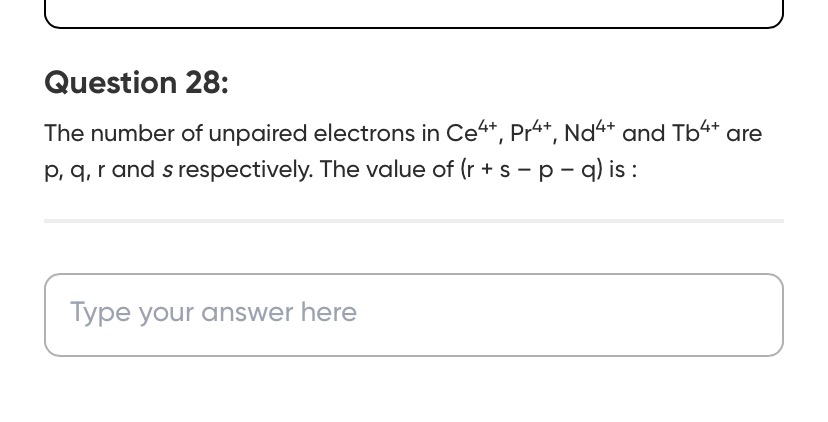Question
Question: The number of unpaired electrons in $\text{Ce}^{4+}$, $\text{Pr}^{4+}$, $\text{Nd}^{4+}$ and $\text{...
The number of unpaired electrons in Ce4+, Pr4+, Nd4+ and Tb4+ are p, q, r and s respectively. The value of (r + s - p - q) is :

8
7
6
9
8
Solution
To determine the number of unpaired electrons for each ion, we first find their electronic configurations.
-
Ce4+: Cerium (Ce) has atomic number 58. Its electronic configuration is [Xe]4f15d16s2. For Ce4+, we remove 4 electrons: 2 from 6s, 1 from 5d, and 1 from 4f. The electronic configuration of Ce4+ is [Xe]. Number of unpaired electrons (p) = 0.
-
Pr4+: Praseodymium (Pr) has atomic number 59. Its electronic configuration is [Xe]4f36s2. For Pr4+, we remove 4 electrons: 2 from 6s, and 2 from 4f. The electronic configuration of Pr4+ is [Xe]4f1. Number of unpaired electrons (q) = 1.
-
Nd4+: Neodymium (Nd) has atomic number 60. Its electronic configuration is [Xe]4f46s2. For Nd4+, we remove 4 electrons: 2 from 6s, and 2 from 4f. The electronic configuration of Nd4+ is [Xe]4f2. According to Hund's rule, these two electrons will occupy different f orbitals with parallel spins. Number of unpaired electrons (r) = 2.
-
Tb4+: Terbium (Tb) has atomic number 65. Its electronic configuration is [Xe]4f96s2. For Tb4+, we remove 4 electrons: 2 from 6s, and 2 from 4f. The electronic configuration of Tb4+ is [Xe]4f7. According to Hund's rule, with 7 electrons in the 7 f orbitals, all 7 electrons will be unpaired. Number of unpaired electrons (s) = 7.
Now, we calculate the value of (r + s - p - q): (r + s - p - q) = (2 + 7 - 0 - 1) = 9 - 1 = 8.
The value of (r + s - p - q) is 8.
